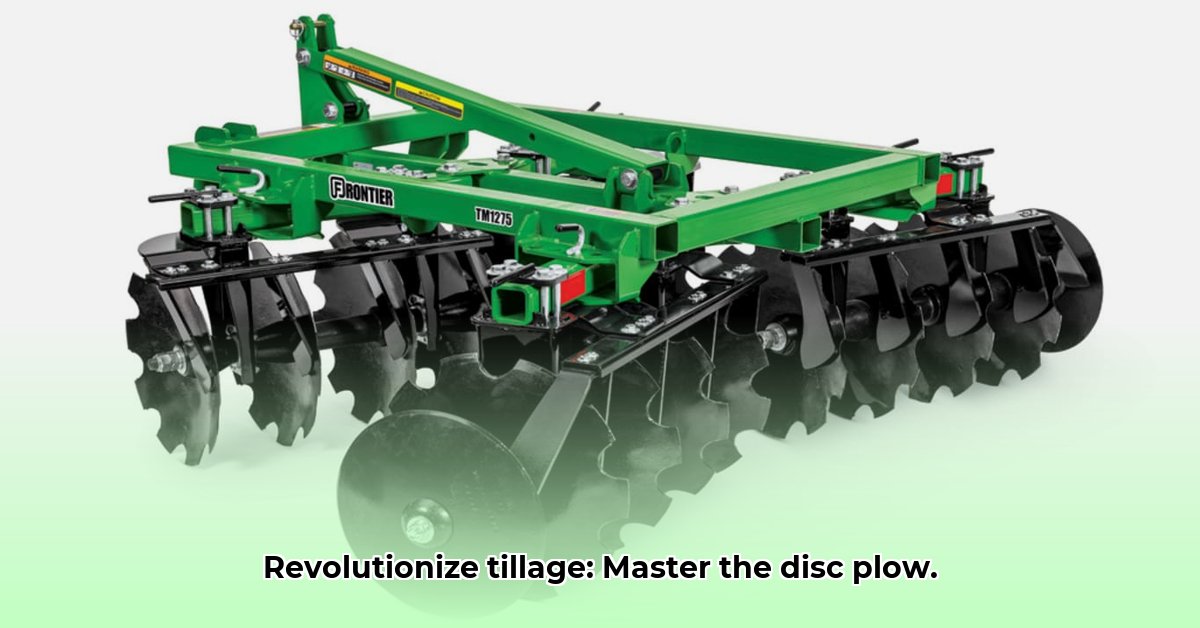
Choosing the right disc plow for your tractor significantly impacts your farm's sustainability and productivity. This guide provides practical advice on selecting, using, and maintaining disc plows for optimal results while minimizing environmental impact. We'll address key considerations, highlight existing knowledge gaps, and encourage participation in future research. For more information on tractor implements, see this helpful resource: tractor implements.
Understanding Disc Plows and Their Role in Sustainable Agriculture
A disc plow uses rotating discs to cut and turn over soil, preparing land for planting, controlling weeds, and managing crop residue. While a vital tool, its sustainable application requires careful consideration of soil type, plowing frequency, and depth. Effective use minimizes soil degradation and maximizes long-term productivity. What are the specific soil conditions on your farm?
Matching Your Disc Plow to Your Soil Type
Soil type dictates disc plow selection and usage. Heavy clay soils benefit from concave discs minimizing compaction and improving drainage. Sandy soils, prone to water loss, require straighter or slightly convex discs to prevent excessive pulverization. Loam soils necessitate careful consideration of moisture and organic matter content. Choosing the wrong disc type can lead to significant soil degradation and reduced yields.
| Soil Type | Recommended Disc Plow Blade Type | Rationale |
|---|---|---|
| Clay | Concave | Minimizes compaction, improves drainage, and enhances soil structure. |
| Sandy | Straight/Slightly Convex | Reduces water loss, prevents excessive pulverization, maintains soil structure. |
| Loam | Variable (adjust based on moisture and organic matter) | Requires careful observation and adjustment based on specific conditions. |
Remember, these are guidelines; on-farm experimentation is crucial for optimizing disc plow use on your specific soil.
Sustainable Tillage Practices with Disc Plows
Sustainable farming emphasizes minimizing environmental impact while maximizing productivity. While disc plowing is a traditional method, it can be incorporated into a sustainable system by reducing plowing frequency, minimizing depth, and integrating cover crops. These techniques promote healthier soil, better water retention, and improved nutrient cycling. How often do you currently plow your fields?
Reducing Plowing Frequency and Depth
Consider reducing the frequency of plowing. Annual plowing might be reduced to every other year or even less frequently, depending on your soil and crops. Similarly, shallower plowing preserves more soil structure and beneficial organisms. What are the impacts of reduced tillage frequencies on your specific crops? Have you considered cover cropping?
Optimizing Disc Plow Usage: Practical Tips for Success
Effective disc plow use involves more than just choosing the right equipment. Proper techniques are crucial for minimizing soil compaction and maximizing effectiveness.
Depth Control: Start shallow and adjust according to soil conditions and goals. Excessive depth damages soil structure.
Blade Angle Adjustment: Experiment to find the optimal angle for your soil, balancing efficient plowing with minimal compaction. This angle may need adjustment based on soil moisture.
Consistent Speed: Maintain a consistent pace to achieve even tillage. Too fast leads to uneven results, too slow can compact the soil.
Regular Maintenance: Clean, lubricate, and replace worn components to prolong equipment life and ensure optimal performance. Regular maintenance will prevent costly repairs.
Addressing Research Gaps and Future Directions
While much is known about disc plow mechanics, further research is needed to fully understand their long-term impact on soil health. Comparative studies contrasting disc plowing with no-till methods are crucial for developing truly sustainable agricultural practices. What specific areas of research are of most interest to you?
Dr. Emily Carter, Soil Scientist at the University of California, stated, "More research is needed on the long-term impacts of disc plowing on soil biodiversity and carbon sequestration. Standardized methodologies for assessing soil health following different tillage practices would significantly aid this research."
A Call to Action: Bridging the Knowledge Gap
To enhance our understanding of sustainable disc plowing techniques, we need collaborative efforts:
Farmer-led data collection: Track your results experimenting with different plowing depths, frequency, and blade types. Sharing this data is crucial.
Standardized research protocols: Adopting standardized protocols for evaluating soil health following tillage practices allows for more robust comparisons between studies.
Manufacturer innovation: Supporting manufacturers in developing more sustainable disc plow designs is critical for long-term advancements.
By working collaboratively, farmers, researchers, and manufacturers can improve sustainable agricultural practices centered around disc plow technology.